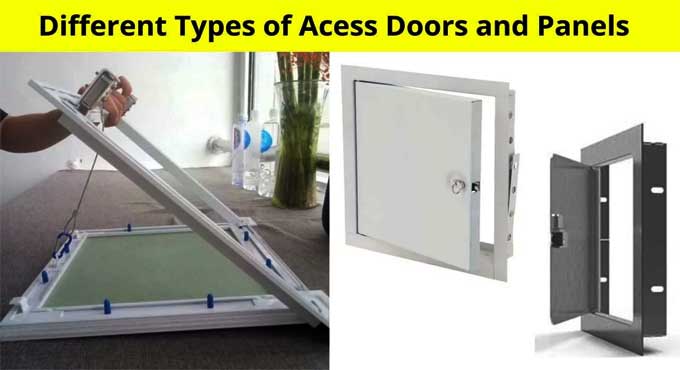
Making Building Maintenance easier with Access Doors and Panels

The ability to access critical areas behind ceilings, floors, walls, and roofs is imperative in residential and commercial buildings. In order to reach essential building utilities, such as mechanical, electrical, plumbing, and HVAC parts and components, access doors and panels are essential. There are now a variety of uses and applications for them.
Providing safe access to specific equipment within confined spaces is the purpose of access doors. They provide access to compartments through small hinged doors. They do not include floor hatches or roof hatches since they are separate products.
Define Access Doors and Panels
Access doors and panels are components of a building that provide a secure way of entering or exiting the structure. They are typically made from steel, aluminum, or other durable materials and have a locking mechanism to keep them secured. Access doors and panels provide a means of access to various areas, such as storage, machinery, or other areas that need to be kept secure.
They also provide a safety measure to prevent unauthorized personnel from entering an area. Access doors and panels can be manually opened or operated with an electronic key or card reader. In addition to providing security, access doors and panels can be used to create an aesthetically pleasing look to a building.
Types of Access Doors and Panels
Duct Access Doors
Whether in a commercial or residential setting, duct access doors enable easy access to ductwork components. A hole must be cut in the duct to install the panel. There will be no obstruction to the ventilation airflow system because it will provide an airtight, grease tight, and fire tight seal.
It allows maintenance tasks such as repairs, inspections, and cleaning to be performed with ease and permits easy access to the ductwork.
During ductwork cleaning, they are necessary because if the ductwork is inaccessible, there will be no way to remove oil buildup, dirt, and grease, which can lead to a serious problem in the future. Additionally, some components of the ductwork system, including fans, can be affected by these buildups.
Sound Rated Access Doors
Through their noise reduction feature, these sound rated access doors enhance the privacy of building facilities beyond safe accessibility and maintenance. These access doors generally provide sound transmission blockage and noise containment for walls thanks to their top grade insulation.
Acoustic insulation makes these access doors ideal for judicial settings, performing arts and music studios, health care facilities, and schools that have to comply with government privacy regulations.
Fire Rated Access Doors
There are different fire resistance characteristics among fire rated access doors. Their goal is to assist in the prevention of fires in buildings. For scheduled preventive maintenance, inspections, and repairs of building fixtures, this type of access door provides convenient and unlimited access. In fire situations, they prevent smoke from being transferred from one door to another. Self locking and self closing mechanisms make them fire retardant for 48 to 72 hours.
Airtight or Watertight Access Doors
A watertight or airtight access door is resistant to air infiltration and water penetration. It has a fully gasket and weld door frame and door. Operating rooms, clean rooms, laboratories, and any building space that requires an airtight or watertight seal are ideal applications for this type of access door.
To learn more, watch the following video tutorial.
Video Source: A Concord Carpenter / ToolBoxBuzz
Furthermore, they can also be used in exterior installations, providing protection from the outdoors and safe accessibility to system components during inspections, repairs, and maintenance.
Wrapping it Up
Access doors and panels made of stainless steel are available on the market. A flush mounted window is an option, along with one that's recessed, equipped with vents or louvers to facilitate airflow, and one that's accessible through a window. Door and panel access is also classified based on the location and size of the surface material. A professional should be consulted before installing one for every surface and area.


